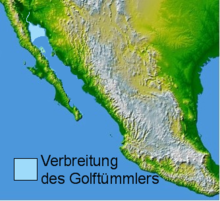Gulf of California
| Gulf of California Mar de Cortés |
|
|---|---|
|
Map of North America, Gulf of California highlighted in purple |
|
| Waters | Pacific Ocean |
| Land mass | North America ( USA , Mexico ) |
| Geographical location |
28 ° N , 112 ° W
|
| width | 230 km |
| length | 1 100 km |
| surface | 160,000 km² |
| Islands | Tiburón , Angel de la Guarda , San José |
| Tributaries | Colorado River |
|
Gulf of California near San Carlos, Mexico |
|

The Gulf of California (also Sea of Cortés ) ( Spanish Mar de Cortés / Golfo de California / Mar Bermejo , English Gulf of California / Sea of Cortés / Sea of Cortez ) is a 160,000 km² tributary sea of the Pacific between Mexico and the Baja California Peninsula . It is about 1100 kilometers long and 90 to 230 kilometers wide. In the north is the delta of the Colorado River . The two larger islands of the Gulf can also be found in the northern part: Isla Ángel de la Guarda and Isla Tiburón . The region of the Gulf lies in an active tectonic fault zone , which among other things created the Caldera Aguajito .
The Gulf of California belongs to Mexico .
history
The golf was named Mar de Cortés by the Spanish explorer Francisco de Ulloa in 1539 in honor of the conqueror Hernán Cortés . Ulloa originally believed that the gulf was the beginning of the legendary Strait of Anián , which was to connect the Pacific with the Atlantic Ocean .
Around 1540, Melchior Díaz carried out several exploratory trips in the Gulf, including the lower reaches of the Colorado River , which flows into the northern part of the Gulf.
fauna

The small part of the sea is home to a unique and rich ecosystem . In addition to a large variety of endemic animals and plants, many migratory species such as the humpback whale , the gray whale , the manta ray , the bow-forehead hammerhead and the leatherback turtle can be found here. There is a subpopulation of fin whales in the Gulf of California that does not migrate annually. She lives in this area all year round and switches her diet to fish when the krill becomes rarer.
The Gulf of California is also the only place on earth where the the extinction of endangered California porpoises are found. Since the kind of significant risk of extinction, was founded in 1993 in the north, a more than 930,000 hectares of large marine reserve established. Attempts by the Mexican government to set up further protected areas have so far failed due to the possibilities for enforcement and political disagreements: The several thousand kilometers of coastline are difficult to monitor, and the commercial fishing industry has formed a politically strong community that has little interest in it has to ban fishing.
fishing
Commercial fishing has been a major source of income in the region for a long time. Several writers report that schools of tuna are said to be more than 150 kilometers long. The Gulf of California has also traditionally attracted large numbers of sport fishermen .
Today the sea is still visited by many tourists, but due to overfishing , fish yields are slowly falling. The fish Totoaba is particularly affected .
World heritage
In 2005, numerous islands and stretches of coastline in the Gulf were added to the UNESCO World Heritage List . Because of the feared extinction of the porpoise, the world heritage was put on the Red List of World Heritage in Danger in 2019 .
Web links
- Entry on the UNESCO World Heritage Center website ( English and French ).
- The golf dolphin
- Croatian missionary and researcher Ferdinand Konščak explored the Gulf of California in the 18th century
Individual evidence
- ^ Watching Giants - The Secret Lifes Of Whales Elin Kelsey, University of California Press, 2009. ISBN 978-0-520-24976-9
- ^ The Islands and Protected Areas of the Gulf of California (Mexico) inscribed on the List of World Heritage in Danger. UNESCO World Heritage Center, July 3, 2019, accessed July 6, 2019 .


